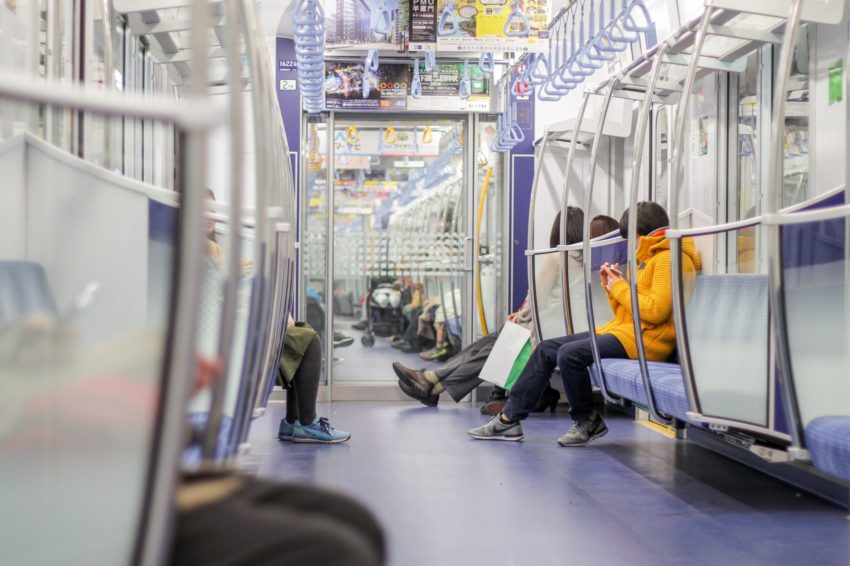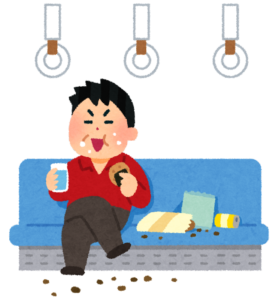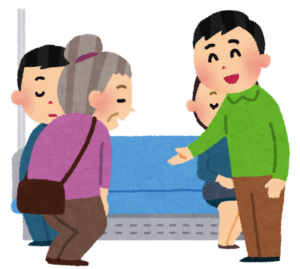Don’ts and Do’s of Train Riding

Top Photo by Satria Hutama on Unsplash
If you’ve ever thought about coming to Japan, there are a few things that you need to know before you do. Take you shoes off when entering someone’s home. Learn how to use chopsticks. You know the drill. But what you may not be familiar with is proper train etiquette, as there is such a thing. While some of it can be summed up as “basic common sense”, some of it might be different than what you’re used to in your own country. Here’s the basics:
Don’t: Talk on the Phone
 Simply put, when you’re on the train (or a bus), don’t talk on the phone. This may sound a little strange, as obviously talking to other people on the train is fine. So why shouldn’t talking on the phone be allowed?
Simply put, when you’re on the train (or a bus), don’t talk on the phone. This may sound a little strange, as obviously talking to other people on the train is fine. So why shouldn’t talking on the phone be allowed?
There are two main reasons for this. The first is that while talking on the phone, some can talk louder than they may usually do in person, disturbing other passengers. On occasion you may see someone on the phone, and you will most definitely hear them.
While taking a quick call at a station stop is generally overlooked, talking at full volume in a crowded train in motion is not going to endear the speaker to anyone.
The second and more important reason is that the phone signals may interfere with pacemakers and other medical equipment some of the other passengers need to live. If you absolutely must speak on the phone, try to avoid standing near the priority seats (at either end of a train car) where these types of passengers would be most likely to sit.
The proper thing to do though is simply wait until your next stop and return the call on the platform. In this day and age, sending a text when someone doesn’t pick up is pretty much accepted.
Do: Look at Your Phone
 On the other hand, using your phone silently (or with headphones) isn’t just accepted, it’s practically essential. In any given train care, at least 75% of the passengers seem to be staring at their phone reading, texting, watching a video or playing a game. It’s the ideal way to pass the time, especially as books can be somewhat cumbersome.
On the other hand, using your phone silently (or with headphones) isn’t just accepted, it’s practically essential. In any given train care, at least 75% of the passengers seem to be staring at their phone reading, texting, watching a video or playing a game. It’s the ideal way to pass the time, especially as books can be somewhat cumbersome.
Listening to music (or sound from a video) is fine, but be mindful of the volume level. Also, know that it can be difficult to hear over the sounds of travel and background noise (as talking to friends/colleagues is, of course, completely OK).
When you exit the train, be sure to avoid walking and looking at your phone- like many places in the world, accidents have resulted from it and is frowned upon or becoming outright banned in some areas. If you need to check GPS or a map app, find a wall to stop at or a less crowded area to move into.
Don’t: Eat and Drink (Most of the Time)
 This one should be a given in this post-COVID-19 world, but chances are that as normalcy slowly creeps back into our lives, you may see times when it is ignored. As we have touched on before, eating while walking is something of a faux pas in Japan, but this also extends to eating on the train, even while sitting.
This one should be a given in this post-COVID-19 world, but chances are that as normalcy slowly creeps back into our lives, you may see times when it is ignored. As we have touched on before, eating while walking is something of a faux pas in Japan, but this also extends to eating on the train, even while sitting.
Eating can be a messy activity even at the best of times, and you wouldn’t want someone spilling crumbs all over you, right? While drinking from a PET bottle gets a little bit more of a pass, in general try to avoid making a habit of it. Nobody wants to accidentally spill their drink all over a crowded train.
The big exception here is that when in train cars with forward-facing individual seats (such as the Shinkansen) it is encouraged to eat and sample the many regional station-specific obento and snacks. Even alcohol (in moderation) can be consumed openly. Just use common sense; you would eat on an airplane but probably not on a crowded subway, right?
Do: Mind Your Bags
 While Japan is still generally a safe country and pickpocketing is a rarity, it’s always good to exercise caution and mind your bags on a crowded train. But wearing your backpack on the front side is beneficial for another, more immediate reason: you won’t risk accidentally hitting someone behind you!
While Japan is still generally a safe country and pickpocketing is a rarity, it’s always good to exercise caution and mind your bags on a crowded train. But wearing your backpack on the front side is beneficial for another, more immediate reason: you won’t risk accidentally hitting someone behind you!
Having more control over your personal space & belongings helps ensure your commute is a smooth one. You can also use the overhead racks if they are present and available (make sure not to forget your bags though!)
When you have larger luggage, people will generally understand if you take up a little more space. Try not to become an obstacle though, and always keep luggage on the overhead racks or floor in front of seats (and not on them, obviously).
Don’t: Be a Space Hog
 When sitting on a train, try to take up as little space as possible so that others may also sit. As social distancing practices begin to fade, people are much more inclined to fill up the seats. So be aware that if you decide to sit, you’ll most likely be shoulder-to-shoulder with others.
When sitting on a train, try to take up as little space as possible so that others may also sit. As social distancing practices begin to fade, people are much more inclined to fill up the seats. So be aware that if you decide to sit, you’ll most likely be shoulder-to-shoulder with others.
You probably have heard about how some won’t sit next to you out of fear of having to speak English, or some other imagined reason. We can tell you that 99.9% of the time that isn’t the case and people would rather sit than stand because they’re afraid of sitting next to a non-Japanese person. But there are times you might have an open seat next to you, for whatever reasons (the closest passengers may be about to exit at the next stop, for example).
Even if you’ve got the free space, don’t be that guy in the picture taking up more than he needs. Stay compact and allow others to sit if they wish- most of the time, others will do the same courtesy for you. And if you happen to be a larger person who’s going to take up a little more room naturally, well, just do the best you can!
Do: Offer Your Seat
 Every so often the opportunity comes up to be a good Samaritan and increase that invisible honor ranking. Offer your seat up to anyone walking with a cane or crutches; pregnant ladies or those with infants; or any little old grannies (or grandpas) you see.
Every so often the opportunity comes up to be a good Samaritan and increase that invisible honor ranking. Offer your seat up to anyone walking with a cane or crutches; pregnant ladies or those with infants; or any little old grannies (or grandpas) you see.
Keep in mind many people even into their late 60’s and 70’s have no problem standing and may feel awkward if you see them as being *that* old, so assess carefully before giving up your seat. But in general it’s a pretty safe bet they’ll be appreciative. After all, everybody likes being able to sit down!
When riding any form of transportation in Japan, please keep these in mind. Unless you live in a more suburban/rural area and mainly commute by bike or car, chances are you’ll be taking the train a lot. It’s always smartest to practice good manners and help make it a smooth ride for everyone- including ourselves!
Photo Credits:
Top Photo by Satria Hutama on Unsplash
Additional Images: Irasutoya.
All other content (text) created by the original author and © 2021 MUSUBI by Borderlink
RELATED
-

Short Takes: A New Language Is A New Life
Top photo: oadtz on Pixabay Even with a new year underway, it can be easy to feel held down by the problems of… -

Why You Need to Try Kendama
Top photo: stux on Pixabay Over the past 10 years, a traditional wooden toy has been making a resurgence thro… -

Finding Beauty in Everyday Japan
Top photo: Kanenori on Pixabay When most think of Japan, they tend to think of the food, technology, history, …
PEOPLE

The MUSUBI Staff
Collaborative works put together by our many talented writers and editors!


